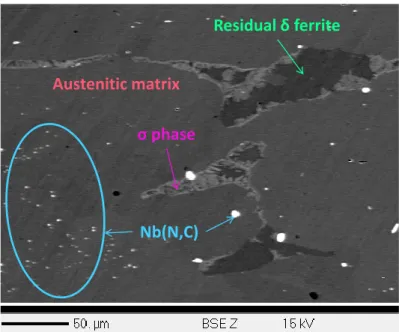HAL Id: cea-02509181
https://hal-cea.archives-ouvertes.fr/cea-02509181
Submitted on 16 Mar 2020HAL is a multi-disciplinary open access
archive for the deposit and dissemination of sci-entific research documents, whether they are pub-lished or not. The documents may come from teaching and research institutions in France or abroad, or from public or private research centers.
L’archive ouverte pluridisciplinaire HAL, est destinée au dépôt et à la diffusion de documents scientifiques de niveau recherche, publiés ou non, émanant des établissements d’enseignement et de recherche français ou étrangers, des laboratoires publics ou privés.
Study of the influence of phase transformations on
mechanical properties in a stabilized austenitic stainless
steel (316nb)
W. Jolly, T. Guilbert, P. Wident, C. Toffolon-Masclet, B. Marini, L. Allais, F.
Buy, S. Ringeval, E. Suzon, F. Cortial, et al.
To cite this version:
W. Jolly, T. Guilbert, P. Wident, C. Toffolon-Masclet, B. Marini, et al.. Study of the influence of phase transformations on mechanical properties in a stabilized austenitic stainless steel (316nb). PTM 2015 - International Conference on Solid-Solid Phase Transformations in Inorganic Materials, Jun 2015, Whistler, Canada. �cea-02509181�
STUDY OF THE INFLUENCE OF PHASE TRANSFORMATIONS ON
MECHANICAL PROPERTIES IN A STABILIZED AUSTENITIC
STAINLESS STEEL (316NB)
W. Jolly1, T. Guilbert1, P. Wident1, C. Toffolon-Masclet1, B. Marini1, L. Allais1, F. Buy2, S. Ringeval2, E. Suzon2, F. Cortial3, Ph. Petit4
1CEA-Centre de Saclay/DEN/DANS/DMN; Gif-sur-Yvette; 91191; France 2CEA-Centre de Valduc; Is-sur-Tille; 21120; France
3DCNS Research-CESMAN; La Montagne; 44620; France 4Aubert & Duval-Usine des Ancizes; Les Ancizes; 63770; France
Phase transformation ; Austenitic stainless steel ; 316Nb ; Thermical treatment ; Precipitates ; Nb(N,C) ; Sigma phase ; Microstructural characterizations ; Mechanical testing
Stabilized austenitic stainless steels (316Nb type) are usually used for components exposed to significant thermo-mechanical stresses in corrosive environments, mostly in the chemical, nuclear and oil industries.
Different phases can be found in the austenitic matrix: retained δ ferrite, σ phase, and primary and secondary niobium carbonitrides – Nb(N,C) (Figure 1). σ phase can precipitate in δ ferrite islands depending on the cooling rate after high temperature heat treatment. It is known to induce embrittlement in austenitic stainless steels because of its very poor coherence with austenite and its own brittle behavior. It also lowers corrosion resistance by dropping chromium and molybdenum contents in the austenitic matrix. Nb(N,C) are the consequence of the reduced solubility of Nb in austenite. Nb prevents the formation of chromium carbides, and thus chromium depleted areas. Finally, the precipitation of fine intragranular Nb(N,C) also improves creep resistance, yield strength and ultimate strength.
Figure 1 : SEM micrograph showing niobium carbonitrides, δ ferrite and σ phase in the austenitic matrix. Residual δ ferrite
Nb(N,C) Austenitic matrix
In the present work, in order to link microstructure and mechanical properties, a large range of metallurgical states with different phase fractions was performed by annealing specimens at 1100°C for 30 minutes and quenching to room temperature at cooling rate between 20 and 200°C.min-1. The influence of phase transformations on mechanical properties has been studied by means of microstructural characterization by thermo-electrical power (TEP) and microhardness measurements, SEM and WDS observations, and mechanical testing. This study notably aims to demonstrate the role of each phase in the fracture strength.
The TEP measurements are particularly sensitive to variations of elements phase fractions in solid solution, dislocation density and crystallographic texture. The TEP measurements of the studied material evolve as a function of cooling rate. Correlating with SEM examination, this evolution seems to be linked to the δ ferrite and σ phase fractions - Nb(N,C) fraction remaining constant. Thus, it appears that TEP measurements are sensitive to the increase of sigma phase precipitation in δ ferrite.
In order to link microstructure and mechanical properties, all different metallurgical states were tensile tested and the fracture surfaces were analyzed by EDXS. EDXS combined with metallographic observations of cross section of the fracture surfaces, allowed to differentiate the various macroscopic areas constituting the material (primary Nb(N,C), the δ ferrite islands, σ phase and the austenitic matrix) and thus to identify the main fracture areas. This technique shows the presence of Nb in the dimples, characteristic of ductile fracture (Figure 2).
Figure 2 : EDXS maps of Nb (blue) and Cr (pink) showing Nb(N,C) in austenitic matrix after 1100°C-30min isothermal holding and quenched at 20°C.min-1 (left) and at 200°C.min-1 (right).
With no or very few σ phase fraction, primary Nb(N,C) control the ductile fracture in this material. However, the σ phase controls the fracture when its fraction due to the δ ferrite transformation exceeds about one percent.
At last, these observations and the composition of the phases obtained by WDS measurements have allowed completing the input data used in CALPHAD tools such as DICTRA and MatCalc, and precisely modelling the phase transformations. Thereby, the simulated equilibrium phase diagram shows the variation of Nb(N,C) fraction with temperature. This result was verified by Rietveld refinements on neutron diffraction diagrams obtained during heat treatment.

